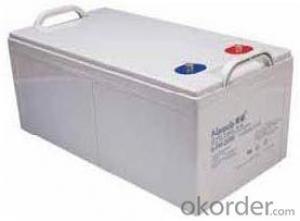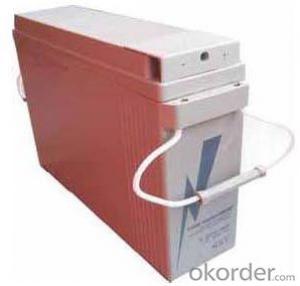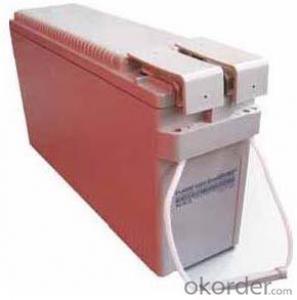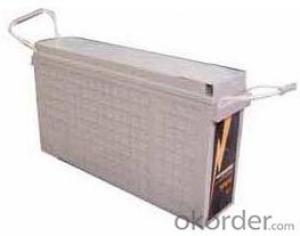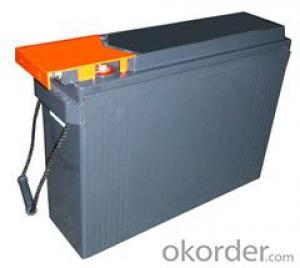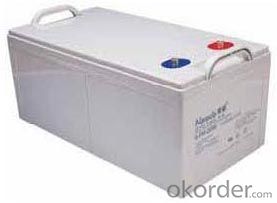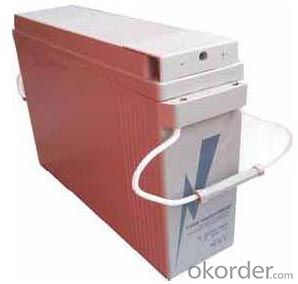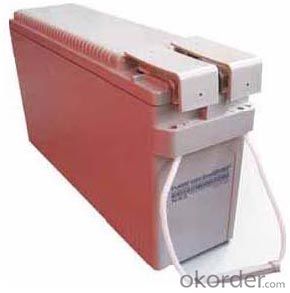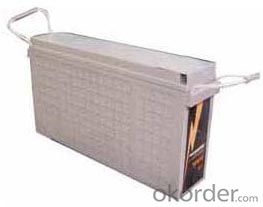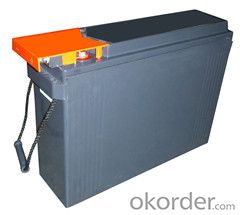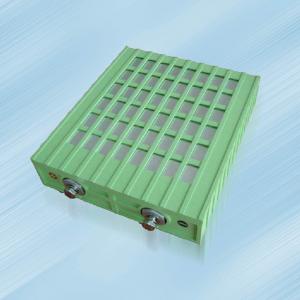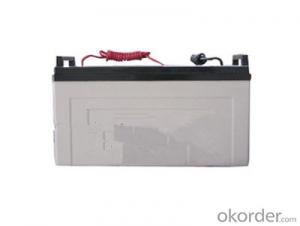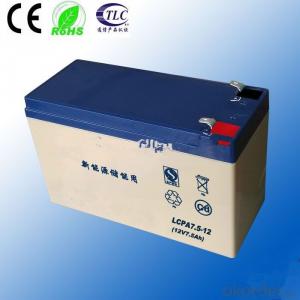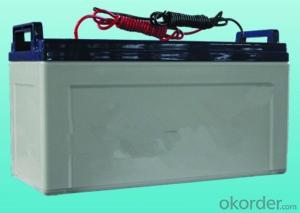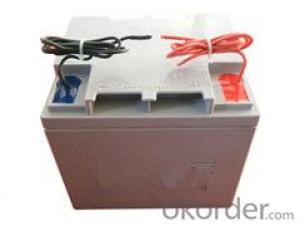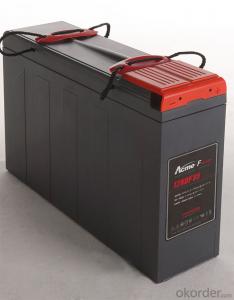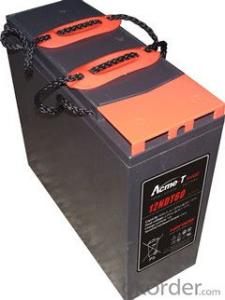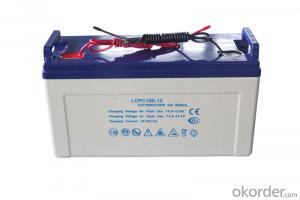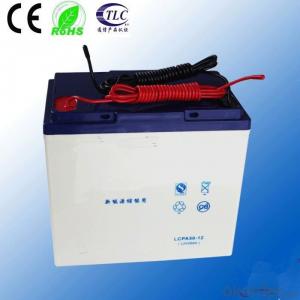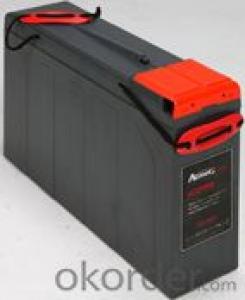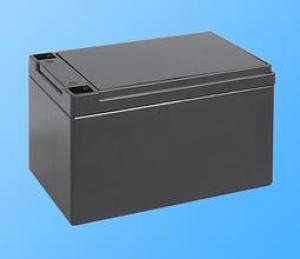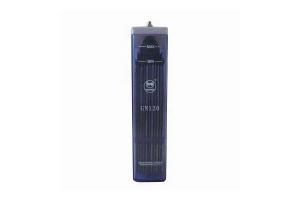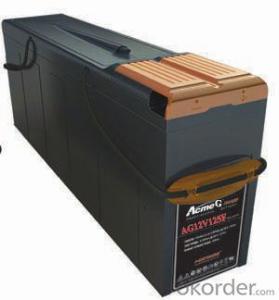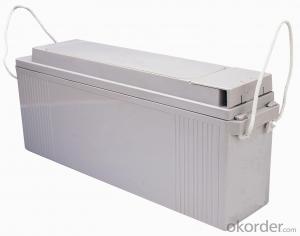VRLA Battery MP Series Battery 6-GFM-125F
- Loading Port:
- Shanghai
- Payment Terms:
- TT OR LC
- Min Order Qty:
- 1000 unit
- Supply Capability:
- 500000 unit/month
OKorder Service Pledge
OKorder Financial Service
You Might Also Like
Range summary:
The MP range VRLA batteries is designed with front terminal structure. The perfect design ensures MP series battery the high reliability and makes the installation quite simple and safe when placed on a standard relay rack tray or in a closed cabinet.
MP range VRLA battery is designed with high energy density and suitable for 19", 23" rack or cabinet, and also offers options of top connection and side of monoblocs connection.Mp range battery can be equipped with central gas collection system according to the requirement of customer.
The MP batteries are ensured the quality with NARADA's QA system according to the ISO9001 standard.
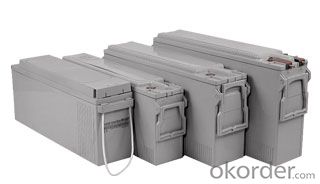
Technical feature:
AGM technology applied in MP range batteries.
Front-access terminal connections for fast and easy installation and maintenance
Suitable for 19", 23" rack or cabinet
Excellent special lead-tin-calcium formula alloy for Grids and plates
Mircoporous glass mats in low resistance as separator
Self-regulating pressure relief valve
12+ years expectant Life under full float service at 25oC(77oF)
Type: | 6-GFM-125F | |
Voltage: | 12V | |
Nominal Capacity: | 125Ah(C10) | 125Ah(10 hours rate:) |
Length: | 558mm | |
Width: | 125mm | |
Height: | 270mm | |
Height with termial: | 270mm | |
Weight: | 47.8Kg |
Compliant standards :
IEC60896-21/22
BS6290 part 4
Telcordia SR4228
Eurobatt guide
UL
Manufactured under system ISO9001(TUV)
Battery installation compliant with:
EN 50272-2 or local equivalents
Main application:
Telecommunications
Uninterruptible power supply (UPS)
Switchgear / utility
Other applications to provide integrated stored energy system
Products characteristics:
Recommended float charge voltage for 12V battery:
2.25Vpc at 25oC(77oF)
Self discharge rate:< 2% per month at 25oC(77oF)
Shelf life: 6 six months at 25oC(77oF)
Valve regulated system, no water addition needed.
FAQ
![]() What is sulfation of batteries?
What is sulfation of batteries?
Sulfation is the formation or deposit of lead sulfate on the surface and in the pores of the active material of the batteries' lead plates. If the sulfation becomes excessive and forms large crystals on the plates, the battery will not operate efficiently and may not work at all. Common causes of battery sulfation are standing a long time in a discharged condition, operating at excessive temperatures, and prolonged under or over charging.
![]() How long a battery can last?
How long a battery can last?
The service design life of a battery are vary considerably with how it is used, how it is maintained and charged, temperature, and other factors.
![]() Do batteries self-discharge when not in use?
Do batteries self-discharge when not in use?
All batteries, regardless of their chemistry, self-discharge. The rate of self-discharge depends both on the type of battery and the storage temperature the batteries are exposed to. However, for a good estimate, Narada batteries self-discharge approximately 4% per week at 80ĄăF.
![]() How can I evaluate the health and charge state of a battery?
How can I evaluate the health and charge state of a battery?
Routine battery examinations divulge irregularities in the charging system as well as in the batteries. The principle method is to examine the electrochemistry of the battery through hydrometric electrolyte inspection. As previously discussed, this important examination cannot be accomplished with sealed absorption or gel batteries. Voltage readings alone require experience to interpret. Hydrometric readings will uncover early warnings of overcharging or overdischarging before batteries are damaged. The state-of-charge and reliability of a lead acid battery can best be determined by the specific gravity of the electrolyte measured directly with a common bulb-type hydrometer with a glass float. We do not recommend the ball float type hydrometer. Specific gravity is a unit of measurement for determining the sulfuric acid content of the electrolyte. The recommended fully charged specific gravity of marine batteries is 1.255 to 1.265 taken at 80ĄăC More than .025 spread in readings between fully charged cells indicates that the battery may need an equalization charge. If this condition persists, the cell is failing and the battery should be replaced. Since water has a value of 1.000, electrolyte with a specific gravity of 1.260 means it is 1.260 times heavier than pure water while pure concentrated sulfuric acid has a specific gravity of 1.835.
- Q: How to repair the battery?
- Connect the positive and negative output of the repair instrument to the positive and negative pole of the battery, open the repair instrument, repair the battery. The first repair time should be no less than 48 hours.
- Q: What is the difference between a maintenance-free battery and a conventional battery?
- As a result of maintenance-free batteries using lead-calcium alloy grille, the amount of water generated when charging less water evaporation, coupled with the shell with a sealed structure, the release of sulfuric acid gas is also very small, so it compared with the traditional battery, With no need to add any liquid, the wiring pile head, wire and body corrosion less anti-overcharge capacity, starting current, power storage time is long, by the car people welcome.
- Q: How to determine the battery is good or bad?
- Instrument test: the general use of battery discharge tester, the test instrument two positive and negative clamp were holding the battery positive and negative electrodes, press the test button to observe the test instrument instructions.
- Q: What are the hazards of battery over discharge?
- When the battery discharge current is large, the heat will become more obvious, there will be serious heat generated when the battery deformation, when the concentration of lead sulfate is particularly large, will form a larger crystal particles, that lead to the battery Internal irreversible sulfation.
- Q: What battery does the van use?
- General use of lead-acid batteries. Electrode is mainly made of lead and its oxide, the electrolyte is a sulfuric acid solution of a battery. English: Lead-acid battery Discharge state, the main component of the cathode is lead dioxide, the main component of the negative lead; charge state, the main components of the positive and negative are lead sulfate. Divided into exhausted batteries and maintenance-free lead-acid batteries.
- Q: What is the meaning of the battery above 12v65Ah?
- 12V is said to be the voltage, 65Ah is the current. (A is the unit of current. H is the time unit .1 hours.)
- Q: The role of the battery?
- Battery is a kind of battery, its role is to be able to save the limited power, in the right place to make 6v4ah emergency light battery. Its working principle is to convert chemical energy into electricity.
- Q: What kind of battery is divided into?
- Maintenance-free battery due to its own structure on the advantages of electrolyte consumption is very small, in the life of the basic need not add distilled water. It also has a shock, high temperature, small size, self-discharge characteristics of the general life is generally ordinary Twice the battery. There are two kinds of maintenance-free batteries on the market.
- Q: Battery 200ah / 104 what does that mean?
- 2V battery capacity (from 200AH-3000AH have) long design, good stability, the price is also expensive; 12V battery capacity is generally the largest 250AH, design life as 2V, price economy, high current discharge better.
- Q: Lead-acid battery how to maintain?
- Open the rubber cap, exposing the exhaust raft, you can see the battery inside, some of the battery exhaust cutting can be unscrewed.
Send your message to us
VRLA Battery MP Series Battery 6-GFM-125F
- Loading Port:
- Shanghai
- Payment Terms:
- TT OR LC
- Min Order Qty:
- 1000 unit
- Supply Capability:
- 500000 unit/month
OKorder Service Pledge
OKorder Financial Service
Similar products
Hot products
Hot Searches
Related keywords
